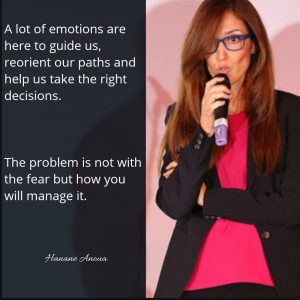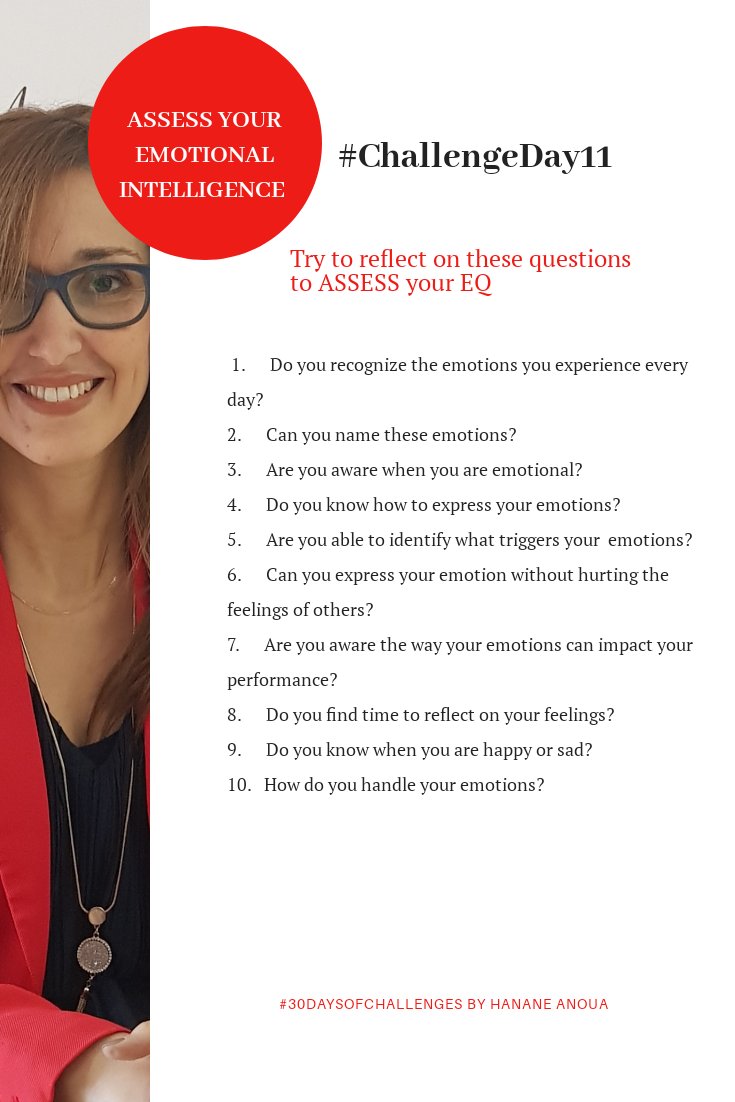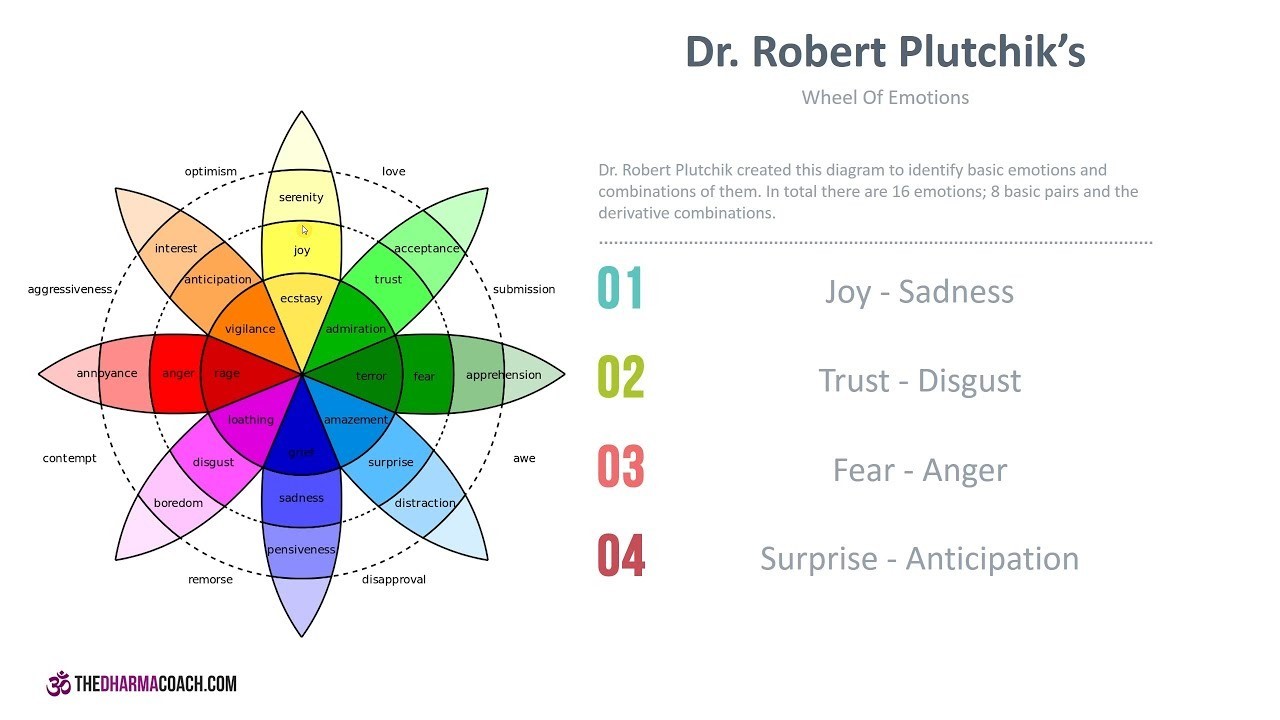Editor's Note: Take a look at our featured best practice, Self Leadership (64-slide PowerPoint presentation). Self-leadership puts together taking responsibility for our outcomes, setting direction for our lives, and having tools to manage priorities. Self-leaders work at all levels of an organization. They are front-line workers in every possible role, middle managers, and CEOs. Self-leaders like Walt [read more]
Challenge Day 11: Understand Your Emotions
* * * *
Editor’s note: This is part of 30-day challenge series written by Hanane Anouna. You can follow along and read the full series here.
* * * *

Understanding your emotions involves an understanding of its three components: the cognitive appraisal can(due to the stimulus, the perception, or what the trigger the event) influence your emotions (expressed through facial expressions or gestures) and impact your behaviors (physiological reaction, attack, isolation…).
Emotional Intelligence (EQ) is being conscious of what trigger your emotion, and your ability to control it to avoid situations that can have disastrous effects on your health and people around you. Emotional intelligence happens when you receive an abusive email from someone, and you take your time to pause and reflect before acting and not reacting.
Today, you can assess your degree of EQ through the way you handle your emotions when driving, in conflict management, in stressful situations, or simply when interacting with people who don’t necessarily agree with you or hold the same beliefs and opinions. Let’s take a quick assessment to your degree of EQ:
History of Emotional Intelligence
The term of Emotional Intelligence was initiated in 1990 by the psychologists, Peter Salovey and John D. Mayer. Later, Daniel Goleman popularized their work in his book, “Emotional Intelligence: Why It Can Matter More Than IQ” and many others. According to him, EQ is “the capacity for recognizing our own feelings and those of others, for motivating ourselves, and for managing emotions well in ourselves and in our relationships.”
EQ encompasses four components: self-awareness, self-regulation, social awareness, and relationship management. These four key elements are the precursor to develop the kill of great leadership.
In this article, I will discuss only the first part related to emotional self-awareness:
To become self-aware, you need first to be in an open mind state to accept to do better and accept positive or negative constructive feedback from others.
When you are self-aware, you will start seeing yourself as others see you, which will give you additional hints to overcome your limitations.
Relationship between our Emotions and the Brain
As discussed in the article “understand the language of the brain?” our emotions and feelings happen at the level of the emotional brain, more precisely, at the amygdala, which also controls the gut feeling and intuitions. When you take a decision even if you know that it is not rational based only on your gut feeling, then it happens at the amygdala.
However, when this part of the brain is hijacked mainly in stressful or dangerous situations, the rational brain will stop functioning properly.
If you are not conscious of what trigger your emotions, how can you control them and take rational decisions? How can you be creative and lead organizations?
If you would like to improve your decision making, you will have to develop your consciousness and be in control of your emotions.
Difference between an Emotion and a Feeling
An emotion is a physical response or a reaction to an external event. They are very easy to identify as they can impact the body conditions (increase of heart beats, breathing, sweat..)
A feeling is a mental reaction to an emotion. Pain is a feeling that can be caused by an emotion like fear.
We all share the same basic emotions but not the same feelings; emotions are instincts but feelings are the interpretation we give to these emotions.
What Are the Basic Emotions
In 1970, Paul Eckman, one of the pioneers in the field of emotions, identified six basic emotions common for all humans independently of the culture: happiness, sadness, fear, disgust, anger, surprise.
Dr. Robert Plutchick (1927-2006) proposed eight primary emotions (joy, trust, fear, surprise, sadness, anticipation, anger, and disgust) that are considered as the foundation of all other combined emotions illustrated in the wheel of emotions below.
The primary and combined emotions are like colors; they can be mixed to create new shades of colors or emotions.
Jealousy is a combination of sadness and fear; Love is joy and trust.
Try to use this wheel of emotions to identify the emotions you are practicing these days as this will give you an idea of the patterns of emotions you are embracing every day.
What trigger them? What are the effects on your attitude and behavior? How do you handle them?
If you don’t know what you are practicing, develop observation, observing your thoughts can tell a lot about your emotions.
How you can control them and use them properly (self-regulation) will be the subject of the coming article.

I found out that there is even worse, like living a life and not feeling alive; living without being conscious and doing nothing to improve it…
A lot of people wake up barely happy, complaining and whining all day, do the same tasks, take their coffees in the same mugs, discuss the same issues… they come back home exhausted with one plan left, embracing their beds… is it your life?
The issue is not becoming conscious of that but doing NOTHING about it. Observing your emotions can tell a lot about your future actions.

Do You Want to Implement Business Best Practices?
You can download in-depth presentations on Self Improvement and 100s of management topics from the FlevyPro Library. FlevyPro is trusted and utilized by 1000s of management consultants and corporate executives.
For even more best practices available on Flevy, have a look at our top 100 lists:
- Top 100 in Strategy & Transformation
- Top 100 in Digital Transformation
- Top 100 in Operational Excellence
- Top 100 in Organization & Change
- Top 100 Management Consulting Frameworks
These best practices are of the same as those leveraged by top-tier management consulting firms, like McKinsey, BCG, Bain, and Accenture. Improve the growth and efficiency of your organization by utilizing these best practice frameworks, templates, and tools. Most were developed by seasoned executives and consultants with over 20+ years of experience.
Readers of This Article Are Interested in These Resources

|
|
50-slide PowerPoint presentation
|
|
2-page Word document
| |||
Top 9 Recommended Documents on Self Improvement
» View more resources Self Improvement here.
» View the Top 100 Best Practices on Flevy.
















